| |
During their industry panel at Otakon 2009, FUNimation representative Adam Sheehan noted that the following special announcement was "not what you think" (Jump Super Anime Tour Special? Kai?). Moments later, fans were treated to the news that FUNimation would be re-releasing the entirety of the DragonBall Z TV series with the "Dragon Box" masters from Japan.
The company has come a long way since 1994 when President and CEO Gen Fukunaga's uncle helped get the startup company the sub-license to distribute the DragonBall franchise in North America. Few licensed anime can say that they have made the transition from an edited, dubbed-only, TV-broadcast-only show to a Japanese-remastered, "hardcore"-targeted complete home release. FUNimation is certainly no longer the company they were fifteen years prior (no doubt in part due to the removal of previously-key employees such as Barry Watson) — they have evolved from the despised to the beloved, and from distributing a meager four properties to having the largest market share, now dictating and disrupting the entire domestic industry.
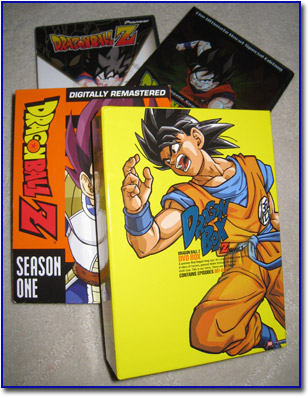
FUNimation's release of the "Dragon Box", and announcing said intentions a mere two months after the completion of their faux-"remastered" debacle, proves this point more than anything else. One has to wonder what ulterior motives may be at play; releasing a "Dragon Box" version of the series just to satisfy a certain sector of fans cannot be enough of a reason. FUNimation, now a wholly-owned subsidiary of the publicly-traded Navarre Corporation, is in the business of making money. Risks may be taken, but the ultimate goal is and always will be to turn a profit. It was naturally assumed that after a DVD release of their "orange bricks", the internally-produced 1080p masters would be re-purposed for a Blu-ray release to double-dip and cash in to bring in the largest gain with the smallest amount of effort. What changed so that this logic no longer made the most business sense? Was it the release of DragonBall Kai in Japan, itself a "refreshed" version of the show in high-definition? Did the license fee for the "Dragon Box" masters (perhaps also due to Kai) reach a point that it became viable and potentially profitable for FUNimation to release them?
Whatever the reason, North American fans are finally being treated to what can most truthfully be defined as the "definitive" version and treatment of the series. We have spoken and written extensively about the history of FUNimation's releases over the last decade and a half. For in-depth coverage and critical analysis of how this all came to be and just why it matters to us, be sure to read our blowout feature first. The background information from our feature combined with this otherwise review-only page should provide you with all the knowledge and history you need to make an informed and educated decision.
So is it true? Did it really happen? Were our dreams and wishes truly fulfilled? Or was there the one, obligatory, major factor in a FUNimation DBZ release that prevents it from being everything it could be?

Review By: Mike LaBrie (VegettoEX)
The majority of this review will be written and presented from the perspective of what it is to most North American consumers: another release of the DragonBall Z TV series on DVD (and in the case of some episodes, for the fourth time). Where appropriate, comparisons to Japanese products (such as the "Dragon Box" sets and single-disc DVDs whose masters they are based on) will be made for purely educational purposes. What a Japanese release did or did not also provide will not be held against the new American product; it will be analyzed and weighed on its own merits and pitfalls.
Since it first began in syndication on North American television in 1996, the DragonBall Z TV series has been constantly re-run (occasionally also in raw Japanese and Spanish courtesy of the International Channel and Telemundo) and re-released on home VHS and DVD. By now, anyone who is interested more-or-less has an idea of how this early part of the story goes:
-
For 153 episodes a boy named Son Goku goes on adventures in search of seven Dragon Balls that summon a dragon to grant a wish; he fights in tournaments; he battles evil villains; he makes invaluable friends...
-
The TV series gets a new name (with a "Z" tacked on)
-
Goku's alien brother Raditz shows up and explains that he is actually from the Planet Vegeta and belongs to a race called "Saiyans"; he was sent to Earth to destroy it, but a head injury as a baby changed all that
-
Goku teams up with his rival, Piccolo, to defeat Raditz, but dies in the process
-
Piccolo trains Goku's son, Gohan, for the next year while Goku trains in the afterlife under Kaiô-sama; the two remaining Saiyans are on their way to Earth to not only take the Dragon Balls for their own, but presumably kill everyone while they are at it
-
Yamcha, Chiaotzu, Tenshinhan, and Piccolo are all killed before Goku arrives
-
Vegeta, the stronger of the two Saiyans, kills his comrade Nappa after his defeat by Goku; Vegeta proves more than a fight for Goku, but is ultimately defeated thanks to some last-minute intervention by Gohan, Kuririn, and Yajirobe
-
With Piccolo killed, Kami-sama and therefore the Dragon Balls all disappear
-
The Saiyans had revealed that Piccolo was an alien from the Planet Namek; if Kami-sama was Namekian and created Dragon Balls, perhaps the Namekians, a peaceful race unlike Piccolo and his father, also had Dragon Balls...? Could they use them to resurrect their fallen comrades?
-
Gohan, Kuririn, and Bulma take off for Planet Namek while Goku remains on Earth to heal
-
Meanwhile, Vegeta is also off to Planet Namek for the Dragon Balls... and it seems like even his overlord is also on to the Dragon Ball game...
If you are reading this review, chances are you already know all that and skipped down ahead. That's fine! You probably also have long-standing opinions on the content of the 42 episodes contained within this box set and no review will change your stubborn thoughts... but in the interest of complete dissection, we will go ahead anyway.
To keep this section (relatively) short, I will simply go on record as saying that the first arc of the DBZ TV series is easily one of my favorites. The characters still have a quasi-rounded, younger design to them, and the ultra-beefy SSJ designs have not yet come into effect... though you could argue that Goku's Kaiô-Ken 4X, non-walkable form is as beefy as they come. Characters genuinely develop over the span of 30-odd episodes. Filler material, while prevalent, still has not reached the ridiculous levels of later storylines; episodes such as the ones with Gohan and the robot and the dinosaur friends are actually endearing. Shunsuke Kikuchi's score goes through its own transformation, using some elements from the later parts of the first TV series while mixing in memorable new motifs that would last the remainder of the series. The animation quality takes a dive at times (such as Goku's long neck while training on Kaiô's planet), but jumps right back up when appropriate — Goku's battle with Vegeta is comparable to the movies' animation at key moments.
While the series spins off in a new direction and would not return to its slapstick and adventurous roots for nearly 200 episodes, it is at its best in this storyline. The viewers are thrust into a whole new universe just as Goku is, and we can feel the same excitement and apprehension battling each other within our blood.
We have all discussed this part of the series so many times since its original airing. In lieu of any further (needless) generalizations, but to still celebrate this part of the storyline to its fullest extent, I present to you, from the first DragonBall Z story arc, and because everyone loves a good list, my...
| |
|
While not the type of scene that makes you tear up as opposed to some others on this list, little can emotionally compare to the first time you view Goku and Vegeta's attacks slamming into each other in a complete stalemate. As Kaiô warns Goku not to, you remain on the edge of your seat as Goku pushes into the Kaiô-Ken 4X. The animation, the seizure-inducing strobe, the screams of pain and determination... it's an incredibly suspenseful scene. |
| |
|
Gohan's entire purpose is to serve as an obnoxious brat with potential that Piccolo (and by extension the audience) can only hope will be brought out when it is truly needed. During Gohan's "survival" training, he slowly crawls out of his shell and begins to open up. When his new dinosaur friend is killed, Gohan is forced to accept the reality of the harsh and unforgiving world. As the tears dry, Gohan leaps into the air, understanding what lies ahead of him and what he has to do. |
| |
|
With both Yamcha and Chiaotzu gone, and Nappa barely having a scratch on him, things are not looking good for the heroes. Tenshinhan's arm has been partially chopped off, but he realizes what must be done. The viewer is treated to a reminiscence-filled apology to Chiaotzu, but with the promise that they will meet again in the next world. Summoning up every last bit of life energy within him, Tenshinhan fires his final Kikô-hô, nearly catching Nappa off-guard. Unfortunately, it was all for naught, which makes the pain of Tenshinhan's resulting death all the more devastating. |
| |
|
Yamcha is dead. Chiaotzu is dead. Tenshinhan is dead. Kuririn is down for the count, and Piccolo's well on his way. Gohan has used up every ounce of strength he has, but it is no good. With a smirk, Nappa raises his foot to crush Gohan, noting how much he is looking forward to seeing the look on Kakarrot's face when he finds his son dead. All of the hopeless feelings are finally washed away when Gohan disappears, Kinto-Un wobbles in with a confused Gohan on top, and Vegeta looks up into the sky... to see Goku staring down at them. |
| |
|
"What a pitiful tale... Imagine, Piccolo-Daimaô, of all people, protecting some kid...." Over the course of the year, the smallest hints of compassion arise within Piccolo. Despite this, he remains a cold and heartless monster seeking nothing but personal gain; defeating the Saiyans is only so he can be the one to take over the world. Nothing could prepare us for Piccolo selflessly tossing himself in front of Nappa's attack. The double-whammy hits when he at first appears to be OK, still standing when the smoke clears... but falls to the ground, begging for Gohan... his only friend... to run and save himself. |
There are of course other emotional moments throughout the story arc. Goku's death, Bulma sobbing at Kame House, Goku's plea for Kuririn to let Vegeta live... the list goes on and on. Toriyama's ability to write by the seat of his pants may not be at the climax of talent just yet (as it will be during the Cell arc), but he knows how to effectively tug at your heart more than he ever has before.
At this point, it should be fairly obvious that I have a deep love and appreciation for this part of the series. It was, after all, the first animation for the series I ever saw. To finally see a North American release treat this segment with the respect it deserves evokes feelings of relief and content that are nigh near indescribable.
I love the entirety of the franchise, and I do believe it is best experienced from the very beginning. DragonBall Z is not the beginning. Without a prior knowledge of characters like Tenshinhan and just how dire the situation with Piccolo-Daimaô was, there is certainly something lost with an immediate jump into Z. Can do you do it? Sure. Is that how most North American fans did it? Sure. You owe it to yourself to discover the wonder that is the rest of the series that came before it, though.
For the first time in North America, DragonBall Z has truly received its "complete" packaging in terms of content. Each episode's respective opening theme (with corresponding credits) is included. Each next-episode preview is included, a first for DBZ (though it had previously been included on the DragonBall GT original single-disc releases). As with prior releases, eyecatches are included to mark the commercial breaks. For fans that remember the VHS fansub days pre- and early-FUNimation, to finally have this style of complete packaging is a nostalgic trip like none other.
Perhaps the only gripe we can make with regard to the actual content within this set is that it ends in such a strange area with Episode 042. This is purely motivated by dividing the 291-episode series into something logical, though. It just sucks to end in the middle of the absolutely atrocious "Fake Namek" filler arc.
We can look past that minor issue, though...!
This is the best-looking release that DragonBall Z has ever, and probably ever will, receive in North America. What else can be said about it? Review over, folks! Thanks for tuning in!
OK, but seriously...
Though we noted we would not dive too heavily into background due to our extensive feature, a little refresher may be in order. Beginning in 2003, Toei (in conjunction with Pony Canyon) began releasing the entirety of the DragonBall franchise on DVD in what they called "Dragon Box" sets. These were limited-edition boxes that could only be purchased via a pre-order program (although retailer sites like Amazon Japan and CDJapan would allow foreign purchasers the ability to obtain them). Unlike anything that had come before with the series, the companies went back to the original 16mm prints (the genuine "masters", so-to-speak, held in cold storage for preservation) for their remastering process. As opposed to what FUNimation and some European rights-holders had received, these were genuine first-run masters; licensees are always given some type of multi-generational master to work from, which itself leads to at least some minute loss of quality (while not being as bad as a VHS-to-VHS copy, think of it in that respect).
FUNimation has certainly received a generational-copy of "the" Dragon Box masters, but a 2nd or 3rd generational modern copy of a careful remastering is in a completely different league than a 5th or 6th generational copy from fifteen years ago.
In terms of previous FUNimation releases of the series, the Dragon Box "wins" by leaps and bounds:
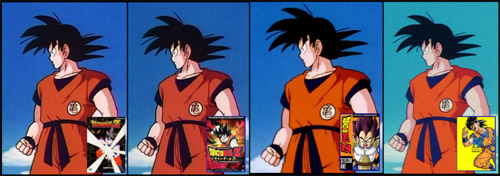
(image courtesy of Tanooki Kuribo; click through for full-size lossless PNG)
FUNimation's first masters were much closer to their true selves, but heavily pushed toward the blue spectrum; greens became blues, while blues themselves became blacks. The "orange bricks" blurred and smoothed away the details and pushed the saturation even further. The Dragon Box master restores the original color scheme and full detail in all areas without compromise.
The slightest dip in visual fidelity from the Japanese releases is almost negligible. Certain absurdly hardcore and enthusiastic fans may bring a valid argument to the table that the colors are not necessarily 100% accurate to the original productions from 1989, but for all intents and purposes, this is how the show is supposed to look.
Dragon Box enthusiasts have, since their original release, spoken endlessly about how amazing the footage looks in motion. I would be lying if I did not say I feel a bit of vindication reading so many comments from North American consumers, now getting their own taste with FUNimation's Dragon Box release, conceding with the exact same conclusion. While it is true that FUNimation's "orange brick" sets also gained a new, progressive transfer from a film master, all of the additional alterations affected the footage in a way that just does not happen with the Dragon Box masters. It is something that a YouTube encode simply cannot convey.

It was a minor point of contention among fans leading up to its release that FUNimation's Dragon Box discs would contain seven episodes each. While this is semi-standard in the North American anime market in today's world, the fact that the Dragon Boxes' main selling point was the video quality brought about some apprehension. With the Japanese discs containing only six episodes and one audio track each, would the addition of an extra episode and extra audio track compromise the video quality in a discernable and impactful way?
|
|
Can you tell which is the R1 and which is the R2...? |
For reference's sake, the original Japanese DVDs ran with a video bitrate hovering around 6 to 7.5 Mbps. FUNimation's discs hover around 4 to 5 Mbps. Without comparing the video streams on a frame-by-frame level, your casual viewing experience between the two will essentially be identical.
The video framing is ever-so-slightly different from the R2 DVD releases. FUNimation's Dragon Box does away with the ~4 pixel left-and-right black buffer present in some episodes on the R2s, but instead has a ~1-2 pixel buffer at the very top of the frame. The placement of the frame also seems to be shifted down by a couple pixels. It is all very minor and hardly affects the viewing experience, but it is worth pointing out.
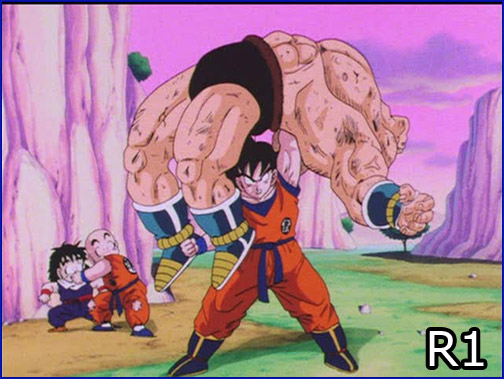
(lossy image comparison for demonstration-purposes only; hover over above image)
Our forum member james039 pointed out to us that a minor difference between what is marketed as "NTSC-J" and standard American releases is a 10% brightness difference due to the way the signals are transferred and presented on the final video hardware. Sure enough, applying a 10% brightness increase to a frame captured from an R2 source brings it to near-identical with the R1 release.
The DVD menu system is a stylistic (yet redrawn) carbon-copy of the original Japanese menus, with the obvious changes in episode counts and English text. The menus are also still images, as opposed to the Japanese motion menus with an actual scene playing in the background. Much to our delight, tunes from Shunsuke Kikuchi's original score play over top the menus. While the show itself is indeed the correct 4:3 aspect ratio, the menus will adjust to display anamorphically on widescreen displays, an update from the Japanese release. The discs auto-play to the main menu (other than included FUNimation trailers, rather than directly into the episodes), and are automatically set to the Japanese language track with its corresponding subtitles.
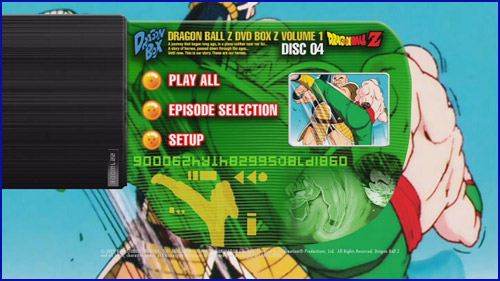
Each disc has its own series of menus:
The one consistent menu from disc-to-disc is the "Setup" screen, which essentially takes the place of the "Story Mode" menu item from the Japanese Dragon Box discs (a feature known as "Marathon Mode" in prior FUNimation releases). This does mean that no "Marathon Mode" is present on the FUNimation Dragon Box discs; "Play All" will literally play each episode with all of its included opening and ending themes, recaps, eyecatches, and previews.
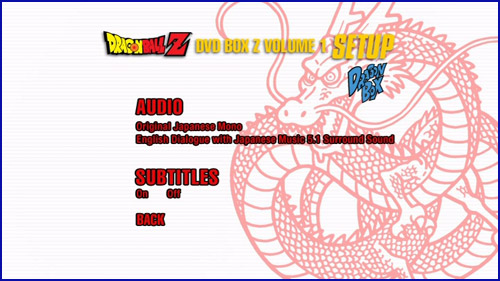
Video quality is not the only aspect that benefits from the Dragon Box masters. Though still clearly a mono soundtrack from 1989, the Japanese track gets a noticeable bump in fidelity from FUNimation's previous masters. Similar to the video, Toei and Pony Canyon went back to genuine audio masters for the series, which are carried over to their North American counterparts. Despite being maxed out on the Japanese releases at 448 kbps (though needlessly encoded into a stereo track), FUNimation has opted for a 96 kbps truly-mono encode. This is satisfactory, and essentially half the overhead given to a stereo audio track on other FUNimation releases (which makes sense, given that "mono" is only a single audio channel stream, while a stereo track transports two distinct channels). While acceptable, there is at least the potential for an ever-so-slight hit to the audio quality on FUNimation's release due to this minor downgrade. As noted earlier, this audio track is played by default (with its corresponding subtitle track) without the need for any adjustments in the setup menu of the disc.
The Japanese mono track is significantly quieter than would otherwise be expected, even compared to the R2 releases. This does not affect the quality in any way, but you will need to turn up your stereo louder than you think. Unlike the Japanese release, FUNimation's Dragon Box encodes the mono track in a single-channel format. The R2 releases encode the audio as a 2.0-channel stereo track (with both channels having the same "mono" sound). This is neither a positive nor a negative; the only thing to be aware of is that some surround receivers may push out a single-channel mono track exclusively to the central-channel speaker. If this occurs and you wish to have the track "separated" and identically sent to the left and right front channels, be sure to research and adjust your receiver's settings appropriately. This is rare, as most receivers will indeed spit the mono track to the left and right front speakers.
Similar to the Japanese releases, the master audio for the opening and ending themes is significantly clearer than the standard episode audio. It can actually be a little jarring going back and forth in audio quality.
Minor adjustments have been made over time to FUNimation's subtitle font and display, and the Dragon Box carries on this tradition. Perhaps the biggest update is the addition of romanized song lyrics at the top of the opening and closing themes, in addition to the standard translation at the bottom. Those who have not already memorized the lyrics provided here on the website can sing along karaoke-style in the comfort of their own living room.
FUNimation's English dub, presented in a single audio track combined with the original Japanese score, is encoded in 5.1 surround at 384 kbps which is standard for their releases. It was confirmed shortly prior to the set's release that an English dub's inclusion at all was an "afterthought", and that the only English audio track included would be the one from the "orange bricks" that contained the original Japanese musical score. FUNimation's English dub, as aired on Cartoon Network with a fully-replaced musical score, is not available on these discs. The FUNimation dub loyalists and their (valid or otherwise) arguments over the necessity of or desires for this track have been deemed irrelevant by the company. For the first time in fifteen years, the dub crowd has not been directly catered to. While no fan has a "right" (cue "entitlement complex" discussion here) to their favorite version of the show, we accept and acknowledge that a vocal sub-group of fans, those that are educated about the "orange brick" debacle and still wish to view the series in its intended way, have not received their "definitive" version.
It may go without saying that we at Daizenshuu EX fully applaud this decision. It is no secret that we have little interest in FUNimation's self-described "reversioning" of the show, and have always geared our content, discussions, and output at the single version of the show that can be and is enjoyed worldwide: the original Japanese version. We live in an era where FUNimation has "rescued" several properties from prior licensors and re-dubbed them with faithful voice casts, accurate translations, and the original Japanese score; one need look no further than One Piece (previously distributed by 4Kids Entertainment) and the upcoming re-do of Initial D (formerly distributed by Tokyopop). A "reversioned" show with a replaced musical score is a relic of domestic anime industry past, a time in the mid-1990s when it was assumed that children were unable to mentally deal with any reference to a show's Japanese origin. To some degree, it almost seems to be to one's personal detriment to continue being a fan of this type of "reversioning" once you realize it was specifically created to cater to the lower-than-lowest-common-denominator. FUNimation's recent re-release of the DragonBall GT TV series, complete with a newly-optional English dub with the original Japanese score (including newly-dubbed versions of the opening and closing themes) was perhaps a precursor to this purist direction for the company and their treatment of the franchise. Up until this point, the DragonBall franchise (and specifically Z) had been FUNimation's only property with this heavy-"reversioning" production. For the first time ever, this is no longer the case.
It may not fully make up for the plethora of mistakes and questionable performances in their English dub (and the original Japanese score does, at times, contrast harshly for what was otherwise intended for FUNimation's replaced musical score), but the effort and intent goes a long way. It shows how the industry has changed, and how the management and staffing changes at the company have not only made them more profitable, but a key player in a larger, publicly-traded corporation (Navarre). Funny how simply treating the show as-is could result in a continued and dedicated fanbase.
The original Japanese R2 DVDs tend to have somewhere in the range of 400-500 MB available disc space left (containing six episodes and one audio track). Given that there is roughly 1 to 1.5 GB still available on FUNimation's discs, and assuming that all remaining discs will be near-identical in their contents and production methods, a slight increase to the video and/or audio bitrate allocation would have been nice. For us, this is hardly a deal-breaker. The Japanese discs were, after all, essentially just thrown into a "max" encoder with less compression than was truly necessary.
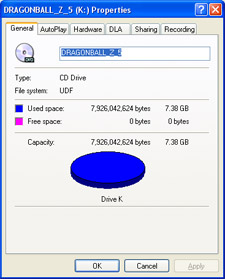
R2 DBZ Single Disc Volume 5
Disc Space Used: 7.38 GB |
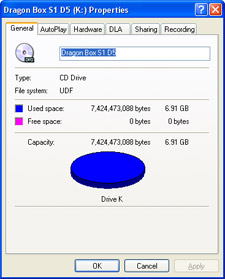
R1 DBZ Dragon Box Volume 1 Disc 5
Disc Space Used: 6.91 GB |
The extra disc space does, however, give the educated and unambivalent FUNimation-dub-and-music loyalists plenty to complain about. If their "perfect" and "definitive" product was compromised by the removal of that particular audio track, and the additional space was not put to use by bumping up the bitrate on either the existing video or audio, is there any particular reason FUNimation could or did not include it?
The available disc space is one aspect of the argument, but it does not take into account the fact that audio and video bitrate are actually a shared component in the DVD specification, and must fit within a certain ceiling limit. Yes, it is technically possible to include a third audio track (as seen with the "orange brick" sets); however, that has the potential to push the video and audio bitrates down even further, and more importantly, push them down in cases where they are most necessary. For comparison's sake, the "orange brick" sets did include three audio tracks along with seven episodes per disc. The video bitrate allocation suffers slightly for this: while it typically hovers around 4.5 to 5 Mbps in-episode, it can dip to nearly 3 Mbps. The 5.1 dub audio track is encoded at 448 kbps, the dub broadcast at 192 kbps stereo, and the Japanese track actually at 192 kbps as (strangely) stereo.
In the end, yes, there is technically space. Should the included audio and video be compromised at all to include it, though? FUNimation appears to have played it on the safe side and kept it to two audio tracks to allow the video to peak where it needs to. Quite frankly, the broadcast audio track does not seem like it would fit in with this product at all, though its inclusion would not appear to be an overly-technical-detriment to the rest of the inclusions. Us, though? We can't complain about it not being there.
At the end of the day, the content and presentation of this set is not for everyone. It is for the fans that have never been directly catered to in the last fifteen years. It is for the fans that have been there for the whole ride. It is for the fans that have spoken their minds with educated viewpoints and their wallets. It is for the fans who deeply care about the series in a way that borders on self-admitted insanity. We are happy to be a part of that crowd.
Since their initial announcement, FUNimation has stated that the goal with their own version of the Dragon Box was to bring North American audiences what the Japanese had... or at least as close to it as they could feasibly provide. Mock-ups displayed immediately after their Otakon 2009 panel showed just that: miniaturized versions of the original Japanese packaging.
The final product is near-identical to the early mock-ups, and indeed a close approximation to the original Japanese style packaging.
Perhaps the only real difference is the way in which the DVDs, themselves, are stacked within the casing. "Stacked" is the best way to describe it, as the atop-each-other style previously seen in the "orange bricks" has been carried over, presumably to save vertical space. Each side of the DVD-holding "book" holds three discs each, with one disc across from two stacked-discs:
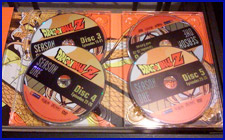
FUNimation Season 1 Set (2007)
|
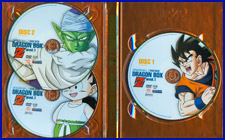
FUNimation Dragon Box Set 1 (2009) |
The discs are imprinted with a character image that corresponds to the content of that disc (in order: Goku, Piccolo, Gohan, Kaiô, Nappa, Vegeta). It is unfortunate that the discs themselves do not state exactly which episodes are on them; however, as all discs have seven episodes, basic math gets the job done.
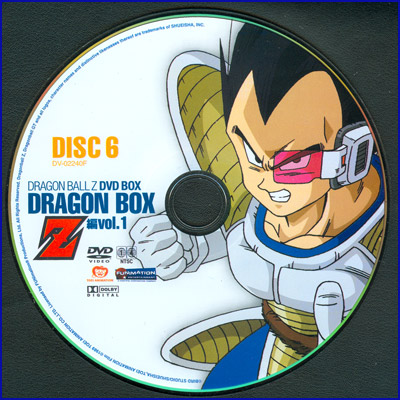
A minor issue cropping up for many buyers is the lack of proper adhesive or construction at the bottom of the box. A closer look at the box reveals that it is actually coated in printed paper, rather than printed directly onto the box itself. This paper seems to globally be pulling away from the bottom of everyone's boxes in a very specific area. While it is not that major of an issue, the fact that it seems to be happening with every single box is a disappointment.
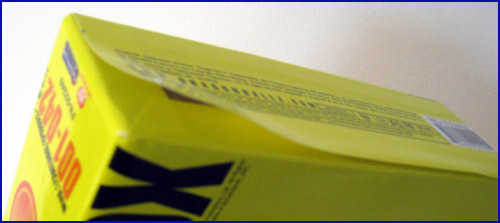
Perhaps the most exciting detail included with overall package was the "Dragonbook". Originally announced as 80 pages, the final product comes in at a modest 48 pages. While it acts as a general episode guide for the set, it also contains a wealth of meta-information relating to the series and its production. We also, for the first time in a FUNimation product other than Japanese-track subtitles, have official spellings of names such as "Tenshinhan" and "Kuririn", as well as attack names written in Japanese alongside their accurate translations.
The "Dragonbook" is broken down into several sections:
|
Over the span of four pages, a recap of the first DragonBall TV series is given. A brief overview of all events is showcased from Goku's meeting with Bulma through the battle with Piccolo-Daimaô, including the special guest appearance from Arale and the rest of the Dr. Slump cast. A heavier emphasis is placed on the 23rd Tenka-ichi Budôkai. Goku's growth (much to the astonishment of his friends), engagement to Chi-Chi, battle with Kami-sama and Piccolo Jr., and Goku's ultimate win of the tournament are all covered. |
|
Over the span of two pages, Son Goku, Son Gohan, Piccolo, and Kuririn are all given detailed character biographies. Their signature attacks and voice actors/actresses are given credit. Extra information such as the race, dreams, and first appearance of the characters are detailed. Of note are the translations of attack names next to their romanizations, and credit exclusively to the seiyû for each character; no English cast credits are provided. |
|
Over the span of two pages, a semi-complete character relationship and familial chart is provided. In addition to diagrams of families, connections between masters and students are also provided. Extra relationships such as Lunch's infatuation with Tenshinhan are detailed by bubbly-hearts. Partners (such as Pu'er to Yamcha) and subordinates (such as Nappa and Raditz to Vegeta) are also detailed. A banner across the bottom of the pages contains a "Character Relations" spread of information that describes the relationship between characters such as Kami and Piccolo. |
|
Spread in a couple of sections throughout the rest of the book is a detailed episode guide. Each episode is given with its translated title, original Japanese air date, and brief description. Special "Close-Up!!" sections detail important events, such as Gohan's growing power as he escapes from dinosaurs, or his growing bond with Piccolo. Characters are also given extra space to shine, with special notes such as the changed color of Vegeta's armor between his first and final appearances. |
|
Over the span of two pages, a Japanese-centric history of the world surrounding the airing of DBZ is detailed. Significant events such as the death of the Showa Emperor and Osamu Tezuka are listed, as well as anime and general entertainment industry items such as the debut of the Nintendo Game Boy, as well as the release of Jojo's Bizarre Adventure and the Dragon Quest anime series. |
|
Over the span of two pages, various non-fighting outfits are detailed for several characters. Yamcha is shown in his baseball outfit; Gohan is shown in his formal-wear before taking off for Namek; Bulma is shown in her spacesuit with a determined look, a dream-sequence with an elegant gown, and finally her sexy, "lived-in feel" of underwear. |
|
Over the span of four pages, character design sketches are showcased, many with interesting anecdotes. Gohan's three designs from first appearance to training to battle are shown. It is noted how characters like Piccolo, Kami-sama, and Mr. Popo have not changed since their introduction. Enma (Yama) is shown as a full-body design with the note that since, "... he is usually shown sitting down, perhaps it is unexpectedly rare to see his whole body." It is noted that Vegeta and Nappa were originally just "Saiyan A" and "Saiyan B". |
There are a couple strange inconsistencies throughout the book, such as the use of both "Saibamen" and "Saibaiman". Many character name misspellings (not dub spellings, but rather flat-out wrong letters transposed) are also spread throughout the book. There are also several instances of "(?)" after particular phrases, which would at first appear to be leftover translation notes that made it into the final product, but are actually carried over from the original Japanese printing.
The book is a wonderful inclusion, and we look forward to each subsequent one with the following box sets, which will presumably carry through with the additional columns and episode guides from the original Japanese books.
The back of the box has an extra "insert"-styled slip with temporary sticky-glue bonding it to the box. It is the same description given to retailers describing the box, its history, and its meaning to fans:
|
Originally produced in limited quantities in Japan, the incredibly rare Dragon Box has long been the ultimate prize for avid Dragon Ball Z collectors. Now this coveted collection has been reproduced for the first time in the United States, delivering the authentic original Dragon Ball Z experience to hard-core fans.
The battle to harness the power of the seven Dragon Balls explodes in vivid detail like never before. The Dragon Box features over 40 uncut episodes, remastered and restored frame by frame, rendering the legendary action in pristine clarity. Each episode is presented in Japanese with the complete opening and closing credits and includes the original episode previews.
Truly the essential edition for Dragon Ball Z purists, this set isn't an addition to your archive - it is your archive. Your wish is finally granted.
The Dragon Box is here.
|
It's cheesy. It's dramatic. It's everything we wanted to hear. Please... keep talking dirty to me.
A current FUNimation catalog pamphlet is enclosed with the box, as well as a double-sided flyer for the latest DragonBall video games:
For a closer look at the packaging of FUNimation's release versus the original Japanese Dragon Box sets, check out the feature over at Kanzentai.
There are no on-disc "extras" for this first Dragon Box set from FUNimation. It is unclear if any future sets will have "extras" as seen on the original Japanese limited-edition Dragon Boxes, such as commercials, the TV specials, etc. The packaging (including the Dragonbook) are the true "extras" for this set, and are all icing on the top of the pristine-presentation of the visual and audio content.
There are a couple minor issues that have cropped up with the sets, however.
Our forum member GizmoKSX came across a high-compressed and macroblocked frame of Nappa at the end of episode five. While brief, it is viewable and slightly jarring during a normal viewing process. Interestingly enough, this identical visual flaw appears on the original Japanese R2 discs, as well. If this is the only visual flaw anyone is able to find, we really have nothing to complain about.
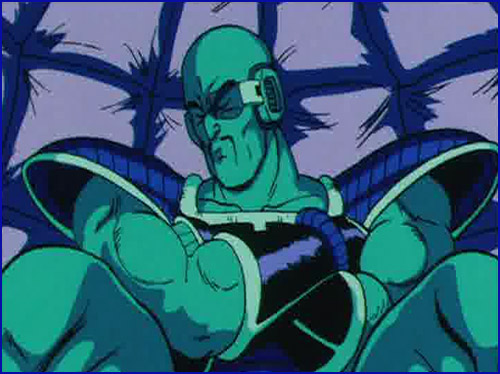
Anecdotal evidence across the internet seems to suggest that certain parts of the English dub audio track may be slightly out of sync with the video. We spot checked several scenes on different discs, and did not notice anything of this sort. We have near-zero familiarity with this cast's dub of these episodes, however, so any adjustments in aspects such as vocal effects are lost on us, and we are unable to comment on any changes that may have been made.
Interestingly, a silent credit roll at the end of the discs appears to be an incorrect and inconsistent listing of production team members. Steve Franko of Video Post & Transfer of all people is listed (almost an unintentional insult at the care and respect put into the Dragon Box masters), along with at least one misspelling of Christopher Sabat's name.

This is certainly another minor issue, but a careless and needless one.
The price of the sets is a hugely-contributing factor to our overwhelming support. For essentially a quarter of the price that the Japanese audience paid for their two gigantic DBZ TV "Dragon Box" sets, American fans will be able to get the same 291 episodes in a video and audio format that very closely rivals the original release. Right now we do not know anything about future on-disc "extras" (such as the TV specials, commercials, other video bonuses), but considering the cost of the sets versus the content contained there-in, it is a price we are willing to pay.
Back when the first volume of the "Ultimate Uncut Edition" came out, our "Feature" at the time concluded with the following statements:
But, ya' know, sometimes I simply want to sit back and watch these episodes fully uncut in Japanese with Steve's translations, and just enjoy the show with a smile.
A decade later, I can finally rest.
Unfortunately, the "Ultimate Uncut Edition" was canceled after nine volumes in favor of the faux-"remastered" season sets. A release of the show that simply "was" ended up being replaced by something that no-one asked for and further divided the enthusiast fanbase.
Nearly six years after those events, we are finally being treated to a version of the show that can simply just be enjoyed. With a smile. More so than anything we have ever been given, and more than we ever hoped to receive.
Closing in on fifteen years later, I can finally rest.
(Yeah, it sounds cheesy. We've been along for one Hell of a ride, though!)

Dragon Box Z Volume 1 is produced and released by FUNimation for the North American market. MSRP $79.98, released 17 November 2009, contains forty-two episodes. Various episodes viewed.
For additional commentary, please listen to Episode #0198 of our podcast.
Dragon Box Z (DBZ TV) Volume 1 is available at the following online retailers:
|
|